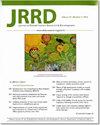Reliability and validity of the inertial sensor-based Timed "Up and Go" test in individuals affected by stroke.
Q Medicine
Journal of Rehabilitation Research and Development
Pub Date : 2016-01-01
DOI:10.1682/JRRD.2015.04.0065
引用次数: 45
Abstract
The instrumented Timed "Up and Go" test (iTUG) has the potential for playing an important role in providing clinically useful information regarding an individual's balance and mobility that cannot be derived from the original single-outcome Timed "Up and Go" test protocol. The purpose of this study was to determine the reliability and validity of the iTUG using body-fixed inertial sensors in people affected by stroke. For test-retest reliability analysis, 14 individuals with stroke and 25 nondisabled elderly patients were assessed. For validity analysis, an age-matched comparison of 12 patients with stroke and 12 nondisabled controls was performed. Out of the 14 computed iTUG metrics, the majority showed excellent test-retest reliability expressed by high intraclass correlation coefficients (range 0.431-0.994) together with low standard error of measurement and smallest detectable difference values. Bland-Altman plots demonstrated good agreement between two repeated measurements. Significant differences between patients with stroke and nondisabled controls were found in 9 of 14 iTUG parameters analyzed. Consequently, these results warrant the future application of the inertial sensor-based iTUG test for the assessment of physical deficits poststroke in longitudinal study designs.基于惯性传感器的脑卒中患者定时“上走”测试的信度和效度。
仪器定时“起和走”测试(iTUG)在提供有关个人平衡和活动的临床有用信息方面发挥着重要作用,而这些信息无法从原始的单结果定时“起和走”测试方案中获得。本研究的目的是确定使用身体固定惯性传感器的iTUG在中风患者中的可靠性和有效性。对14例脑卒中患者和25例非残疾老年患者进行重测信度分析。为了进行效度分析,对12名中风患者和12名非残疾对照进行了年龄匹配的比较。在计算的14个iTUG指标中,大多数具有优异的重测信度,表现为高类内相关系数(范围为0.431-0.994),测量标准误差低,可检测差值最小。Bland-Altman图显示了两次重复测量之间的良好一致性。在分析的14项iTUG参数中,卒中患者与非残疾对照组有9项存在显著差异。因此,这些结果保证了未来在纵向研究设计中应用基于惯性传感器的iTUG测试来评估中风后的身体缺陷。
本文章由计算机程序翻译,如有差异,请以英文原文为准。
求助全文
约1分钟内获得全文
求助全文

 求助内容:
求助内容: 应助结果提醒方式:
应助结果提醒方式:


